The Oldest Cattle Ranch in B.C.
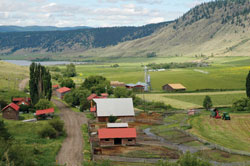 |
|
The main road from Williams Lake (the Dog Creek Road) winds its way right through the ranch yard…all the way to Dog Creek and Clinton. This is the route of the original gold trail to Barkerville and Wells. The silver roofed ranch barn, (right) was built in 1891. The red-roofed building in the foreground was the original blacksmith shop, eventually moved to use as a horse shed. On the left is the Twan home (house with end window). It’s the oldest house on the ranch – built on the site of the old stopping house. |
They travelled to British Columbia from far away lands – by stage, by horseback or on foot depending on the depth of coin in their pockets. They were wanderers, adventurers, second sons and gold seekers.
The Valley of the Waving Bunchgrass or Paradise Valley are but two of the early names given by those early wanderers and settlers to the pretty valley that lies fifty kilometers southwest of Williams Lake, B.C. on the Dog Creek Road. It is the home of B.C.’s oldest cattle ranch. Alkali Lake Ranch can trace its origin back to the mid-1800s. It is now, and always has been, privately owned and operated.
The ranch lies alongside the original river trail that made its way through the Cariboo to the gold fields of Wells and Barkerville, B.C. Scores of men traversed that trail, some recognized the tangible treasures and settled in the lush valley.
One such man who stayed was Herman Otto Bowe. He established a stopping house in what he called Paradise Valley and word soon spread about the quality of his establishment. It was so often described ‘as the place near the lake with the patch of alkali visible on the hillside’ that it is no wonder that it came to be called the Alkali Lake Ranch.
Bowe took a partner, John Koster and together they increased the cattle herd and the land base. They married sisters – local First Nations women from Esket (Alkali Lake) – and raised families. Later their sons, Henry Koster and Johnny Bowe operated the ranch. Young Koster is credited with acquiring the titles for many acres of ranchland that the elder pair had held without deed. In 1909, they sold out to Englishman, Charles Namby Wynn Johnson.
Wynn Johnson significantly increased the land base buying out various neighbours and brought in some new blood, in the form of an American cowboss. Jim Turner had apprenticed under the famous Joe Coutlee of Douglas Lake Ranch, he was well into middle age when he came to Alkali and had considerable ‘cow sense’ and experience. The old way of doing things was tossed aside byJim.
 |
|
Alkali Lake Ranch’s main summer cow camp at U.S. Meadow, circa early 1900s. Paddy Cripps, Wynn Johnson’s daughter, remembered, “The cattle had always been turned out after roundup and left to graze close to home. Jim (Stewart) changed all this. He built a corral up the creek and instead of having one large branding in July, he turned out all of the cattle in early May and drove them as far as U.S. Meadow and on to Emerald Lake. He branded at several places in small bunches. The first year all of the cattle kept coming back to the old range. It took two summers to break the old pattern and the grass near home finally got a rest.” |
Wynn Johnson, who was the grandfather of Chunky Woodward – owned the ranch throughout some of our country’s ugliest periods of history, the First World War and the following depression. He managed to survive those years but the struggle took its toll. In 1939, he sold to the von Riedemann family who fled Austria just prior to the war. Wynn Johnson and Mario Riedemann met each other in a Vancouver gentlemen’s club, Wynn Johnson convinced Mario to try ranching (Mario had been a sugar beet producer and a dairy owner in Austria). He brought his wife Elizabeth and four children: Karl, Myra, Sophie and Martin to Alkali Lake. Wynn Johnson agreed to stay on as an advisor – it was a good thing that he did.
The Riedemann sisters say, “The differences between cattle ranching and our father’s former way of life were so great that father soon began to believe that he had bitten off way more than he could chew. He told Wynn Johnson that he didn’t think he ‘could do this’ and Wynn Johnson told him, ‘of course you can’ – so father stayed.”
Sophie Riedemann says, “We all just loved our new life right from the word go. Wynn Johnson was like a great-grandfather to us – we all loved him dearly. He lived in his own little house, but he came to our house every evening for dinner, except when he was feeling grumpy. He decided which nights those were. He gave us wonderful practical gifts like headstalls or chaps instead of girly, frilly things.”
Sophie also remembers that, “Quite a lot had to be modernized and that Wynn Johnson didn’t really believe in women riding or working. His own daughter, Paddy Wynn Johnson (Harris) (Cripps) broke that mold, though – she far preferred to ride with the men and do a day’s work outside than to do ‘woman’s stuff.’ She paved the way for the rest of us, as did Evelyn Twan who rode with the men at summer cow camp. The Harris children, Jimmy and Cherie, taught the Riedemann children how to ride, smoke reeds, etc. – all the ways of country kids… some good, some bad.”
Mario was a very good horseman but an earlier accident damaged his knee and he could never ride western (it agitated his old injury) – so his continued use of an English saddle in ‘cowboy country’ was the source of much hilarity for the cowboy crew, his daughter Myra recalls. She said that the cowboys had many laughs at his expense over the years.
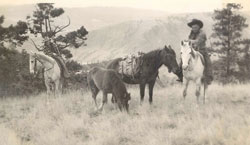 |
Paddy Cripps and Bill Twan on the river range, |
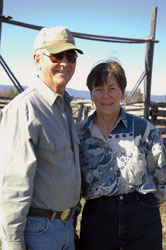 |
|
Ranch owners Doug and Marie Mervyn are the vaccinators at brandings. Doug used to dehorn the calves but it aggravated his bad knee, so he passed that job to Joe Paul. Bronc does all of the castrating. The Mervyns have owned the ranch since 1977; they and the crew have processed a lot of cattle during the 29 years. |
The Riedemann family oversaw the management of the ranch day to day. One man, hired as a cowboy by Wynn Johnson, on June 1, 1937 – would remain for the entire tenure of the family’s ownership (two generations). Bill Twan was the cowboss; he ran the cowboy crew (up to 20), maintained the cattle herd and looked after the range. The family respected and admired Bill and they remained lifelong friends.
Bill was a character and he loved a good prank. He had a keen eye for cattle and he was an excellent horseman, a rodeo competitor and a roman rider. He was known as a firm but fair boss who expected you to do what he asked of you. One of his well-known sayings was, “You are no kind of a cowboy at all if at the end of a long day, you ever look after yourself before you look after your horse” – something he often repeated to his grandchildren.
Mario sold the ranch to his youngest son, Martin, in the mid-sixties. He would operate it until his tragic death, in his mid-thirties in 1976. Martin was an innovator and an outspoken advocate for the cattlemen. He was well-respected province-wide in the industry and his passing was a great loss.
In 1977, after the estate was settled, the Mervyn family from Kelowna would become the new owners and they still own and operate the ranch today. Doug, his wife Marie and the youngest two children, Lisa and Tim moved to Alkali. They were newcomers to the business (Doug had always dreamed of cattle ranching) and Bill Twan stayed a few months to help them settle in before he retired and moved to Williams Lake.
Bill’s son, Bronc remained on the ranch – first as the cowboss, then as the manager, a position he still holds. Bronc was raised on the ranch, he knew every inch of the place; all 37,000 deeded acres and the 125,000 or so acres that the ranch’s range permit encompasses and there wasn’t much about the overall operation that he didn’t know.
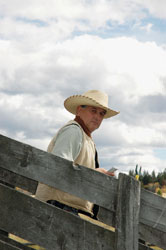 |
|
Alkali Lake Ranch manager Bronc Twan tallies the calves loaded on the cattle liner, bound for the sale in Williams Lake. |
Together Doug and Bronc made sweeping changes – modernization comeswith each new generation of operators. The cowherd was the first thing to change – it was mainly Hereford in 1977 and Doug and Bronc introduced more cross breeding immediately. The hay operation was switched to primarily silage, first in pits, then into bags. The bags hold up to 400 hundred tons each – 2,500 square bales feed the horse herd and a few round bales are made for extra horse feed and for use in the heifer calving yard and sick pen.
Today the ranch is home to approximately 1,550 – 1,600 mother cows, one third of which are straight-bred Herefords, the other two thirds are crossbreds. Known for their ability to graze late into fall and winter while still maintaining their body condition, the Hereford breed is the base and lifeblood of the Alkali Lake Ranch cowherd. There is steep river ranges on the deeded pastures here and the lighter Hereford-cross type cows are better suited to the rugged terrain than the exotic crosses. The red-baldy cows are bred back to black Angus, the terminal cross. The ranch also maintains a herd of 40 – 50 Corriente/Longhorn/Angus cross cows, raising the bull calves to use on the ranch’s first calf heifers. This heifer program (20 years now) – reduces labour costs and stress in calving out 250 – 300 heifers. One hired man does the bulk of the heifer calving.
Alkali is a cowboy outfit, with all of the cattle work done on horseback. The deeded country is semi-desert with cactus, sagebrush and bunchgrass and the cowboys ride all sorts of different terrain. Dogs are definitely man’s best friend and helper here; some days the job would never get accomplished without the help of a good cattle dog. The majority of the dogs are border collies. The river country is steep (shale side hills and sand dunes) and the summer range is forested and inaccessible by vehicle. Cowboys are a necessity. The ranch maintains a horse herd of approximately 70 head; they keep a stallion (Zan Parr Bar bred) and run up to a dozen brood mares. The ranch employs from 4 – 15 people depending on the time of year; they run a bunkhouse with a cook.
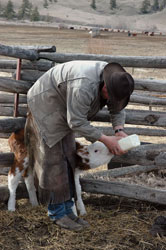 |
|
Willee Twan bottle-feeds an orphan at the heifer calving shed. In a day or two, a new mother will be found. Willee, with help on busy days from Joe Paul, Sandy Johnson andJamie Voight, calved out about 320 heifers in 2006. The heifers were bred to 1/2 Angus – 1/4 Corriente and 1/4 Longhorn – these are straight black ranch-raised bulls. |
Bronc says, “The real problem with ranching today, from a manager’s point of view, is labour. We have several good long-time older employees but it is all but impossible to hire young people. They are working in the oil and lumber industries for big dollars that agriculture can’t afford to compete with. Our knowledgeable workforce is aging, and there will be no one to replace them.”
Alkali Lake Ranch was awarded the B.C. Cattlemen’s Environmental Stewardship award several years ago for improvements to the feedlot that included fencing the cattle off from the creek, building ditches for runoff, and installing waterers for the cattle. Being environmentally aware is a responsibility this ranch is happy to shoulder.
Doug Mervyn is decidedly unhappy about the ever-increasing complexities of modern day ranching. “The seemingly endless new rules and regulations are heaping added burdens on an industry that has suffered greatly over the past few years,” he says. “All the new regulations add cost and responsibility that are greatest to the rancher. The pine beetle epidemic is a good example – the dead trees are falling on all of our fence lines, which in turn means we are not in compliance with fence regulations in the Forest and Range practices code. Ranchers cannot afford the costs of these endless repairs. I am extremely disappointed in the lack of government initiative – they need to step up to the plate. The only real solution is to clear the fence line right-of-ways on both sides to a tree-length back and we need their help to do it. We’re still struggling with the fallout of BSE and we’re entering the downward side of the cattle cycle, which means low prices for several more years. It is time for government to recognize the value of our industry to this province.”
The Alkali Lake Ranch has operated successfully since the late 1850s. Our hope is that cattle ranching, as a way of life and a challenging way of making a living, survives for more generations to appreciate and enjoy. Ranchers live on, and with, the land and have a real respect for it.
Liz Twan lives with her husband, Bronc and two sons, Willee and Jesse on the Alkali Lake Ranch, her home for 28 years now. With her pen and her camera, she records ranch life and local history for those who will come later.













